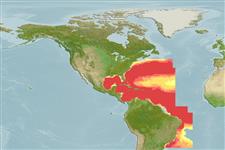Actinopterygii (ray-finned fishes) >
Perciformes (Perch-likes) >
Scombridae (Mackerels, tunas, bonitos) > Scombrinae
Etymology: Thunnus: Greek, thynnos = tunna (Ref. 45335).
Environment / Climate / Range
Ecology
Marine; pelagic-oceanic; oceanodromous (Ref. 51243); depth range 50 - ? m. Tropical; 20°C - ? (Ref. 168), preferred 26°C (Ref. 107945); 43°N - 28°S, 100°W - 26°W (Ref. 55290)
Western Atlantic: off Martha's Vineyard, Massachusetts south to Trinidad Island and Rio de Janeiro, Brazil (Ref. 168); including south of Brazil (Ref. 36453). Highly migratory species, Annex I of the 1982 Convention on the Law of the Sea (Ref. 26139).
Length at first maturity / Size / Weight / Age
Maturity: Lm 49.4 range ? - ? cm
Max length : 108 cm FL male/unsexed; (Ref. 40637); common length : 72.0 cm FL male/unsexed; (Ref. 168); max. published weight: 20.6 kg (Ref. 40637)
Found in oceanic waters, sometimes not far from the coast (Ref. 13628). Forms large mixed schools with the skipjack tuna. Its spawning grounds are located well offshore. Preys on surface and deep-sea fishes, squids, amphipods, shrimps, crabs and stomatopods and decapod larvae. The largest fishery for blackfin tuna operates off the southeastern coast of Cuba and uses live-bait and pole. Utilized fresh, dried or salted, canned and frozen (Ref. 9987).
Life cycle and mating behavior
Maturity | Reproduction | Spawning | Eggs | Fecundity | Larvae
Collette, B.B. and C.E. Nauen, 1983. FAO Species Catalogue. Vol. 2. Scombrids of the world. An annotated and illustrated catalogue of tunas, mackerels, bonitos and related species known to date. Rome: FAO. FAO Fish. Synop. 125(2):137 p. (Ref. 168)
IUCN Red List Status (Ref. 115185)
CITES (Ref. 94142)
Not Evaluated
Threat to humans
Harmless
Human uses
Fisheries: commercial; gamefish: yes
Tools
Special reports
Download XML
Internet sources
